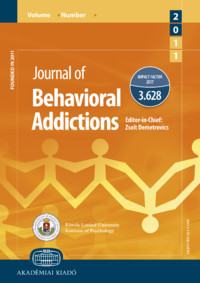Altered functional network activities for behavioral adjustments and Bayesian learning in young men with Internet gaming disorder
Altered functional network activities for behavioral adjustments and Bayesian learning in young men with Internet gaming disorder
Author(s): Shan-Shan Ma, Chiang-Shan R. Li, Sheng Zhang, Patrick D. Worhunsky, Nan Zhou, Jin-Tao Zhang, Lu Liu, Yuan-Wei Yao, Xiao-Yi FangSubject(s): Behaviorism
Published by: Akadémiai Kiadó
Keywords: bayesian learning; post-error adjustment; functional brain networks; independent component analysis; Internet gaming disorder; stop-signal task
Summary/Abstract: Background and aims. Deficits in cognitive control represent a core feature of addiction. Internet Gaming Disorder (IGD) offers an ideal model to study the mechanisms underlying cognitive control deficits in addiction, eliminating the confounding effects of substance use. Studies have reported behavioral and neural deficits in reactive control in IGD, but it remains unclear whether individuals with IGD are compromised in proactive control or behavioral adjustment by learning from the changing contexts. Methods. Here, fMRI data of 21 male young adults with IGD and 21 matched healthy controls (HC) were collected during a stop-signal task. We employed group independent component analysis to investigate group differences in temporally coherent, large-scale functional network activities during post-error slowing, the typical type of behavioral adjustments. We also employed a Bayesian belief model to quantify the trial-by-trial learning of the likelihood of stop signal – P(Stop) – a broader process underlying behavioral adjustment, and identified the alterations in functional network responses to P(Stop). Results. The results showed diminished engagement of the fronto-parietal network during post-error slowing, and weaker activity in the ventral attention and anterior default mode network in response to P(Stop) in IGD relative to HC. Discussion and conclusions. These results add to the literatures by suggesting deficits in updating and anticipating conflicts as well as in behavioral adjustment according to contextual information in individuals with IGD.
Journal: Journal of Behavioral Addictions
- Issue Year: 10/2021
- Issue No: 1
- Page Range: 112-122
- Page Count: 11
- Language: English

